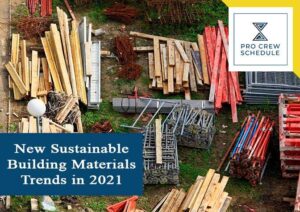The construction industry is leaning towards the sustainable construction trend. Not only is this method environmentally-friendly, but it also makes a building more energy-efficient, hence living becomes more affordable for occupants. On the other hand, sustainable features give more value to the building, giving more profit options for the client. For these reasons, the industry continues to explore different ways to make new construction projects as sustainable as possible. And this 2021, it is expected that construction projects will utilize new green materials.
This coming year, the green construction materials market is projected to reach a value of $1 trillion. This follows the demand for more eco-conscious construction trends as well as non-residential sustainable buildings in the United States.
So, as contractors and subcontractors begin to plan new projects for the coming year, here are new sustainable building material trends to look out for in 2021 and beyond.
Six Sustainable Materials to Use in 2021
1. Composite Roofing Shingles
Roofing subcontractors should start rethinking the type of roof they recommend to their clients. Sheet metals are out as composite roofing shingles will be the better option in 2021. These shingles are made from recycled paper products, fiberglass, and asphalt, which are all environmentally friendly and long-lasting.
Unlike other roofing materials, composite roof shingles are known to be highly durable, fire-proof, wind-proof, impact and fade-resistant, and absorb less moisture. That said, they can last longer than other roof types and require fewer maintenance works. Lesser energy is then consumed throughout the lifetime of this type of roof, hence making it the perfect sustainable roofing for building projects.
2. Smart Glass Windows
Smart glass or switchable glass windows are becoming a significant sustainability trend in the construction industry. In fact, the smart glass market is projected to reach a value of $3.75 billion in 2026. This follows most commercial and industrial buildings now using large windows to allow more light and lessen electrical energy use during daytime. A problem that came with the idea was that the heat also goes through the glass walls. This is how smart glass windows were invented.
Switchable smart glass windows are designed to control light and heat and insulate the building during the day. What’s more impressive is that they can automatically adjust the level of heat and light they need to block depending on the season. For instance, more heat should be waved during the summertime so it turns opaque and its insulating properties adjust accordingly. On the other hand, it turns translucent during the winter to allow more light to come in. Finally, it changes its heating capacity depending on the air conditioning applied in the building. Following these innovative features, buildings using smart windows are able to save up to 30% on energy costs.
3. Bamboo Floors
We are used to hardwood floor panels for cheaper flooring options, but the reality is that they are not sustainable. In the country, most homes are made from wood since they are easy to use in construction. Countless trees are then chopped down.
An alternative that can be considered by construction managers and clients is bamboo, at least for the floors. Bamboos are easy to grow when a normal tree takes 25 years to grow. Bamboos also require very little maintenance to survive. They thrive through drought and can tolerate most soil types. That said, cutting down bamboos to use in many houses’ construction shouldn’t cause any environmental concerns.
In terms of functionality, bamboo floors are versatile. Strand-woven bamboos are exceptionally durable, making them inexpensive alternatives for commercial spaces.
4. Insulated Concrete Framing
In the United States, residential and commercial building projects have the option to use either insulated concrete form or wood frame. In any case, ICF wins over wood frames as they create a more energy-efficient building than one with a wood-frame. They have the capability to control heat and cooling. Since ICF serves as an airtight barrier for the buildings, unwanted energy transfers are prevented while supplying elite thermal mass inside the structure for a more consistent interior temperature. Furthermore, ICF buildings are resistant to fire, moisture, and disaster.
5. Solar Panels
The use of solar panels is no longer new. Many construction projects are now leveraging solar energy to power up a building. The panels may be costly to purchase and install, but the return is quick and big. Just imagine not having to pay for electricity for the whole lifetime of the building. A year of utility savings can immediately make up for the upfront fees of installing a solar module.
6. Eco-Friendly Insulation
Insulation is an essential part of any building for occupants’ health and convenience. Asbestos, which used to be the most widely used insulating material is now discontinued due to the health problems that come with its use.
These days, there are sustainable insulating materials that are as functional but more eco and health-friendly. Some of them include Glasswool or fiberglass insulation, polyester insulation, cellulose insulation, sheep’s wool insulation, and earth wool insulation.
Another emerging insulating technology is hemp insulation. A 92% natural hemp insulator can maintain all similar insulative properties of fiberglass or cellulose insulators, but it has the advantage of being compressed. That said, a 5.5″ hemp can be installed between 3.5″ studs to provide a 19.25 R-value, which is over the requirement in the coldest zone in the United States.
Continuing Building Material Issues
1. Building Material Supply Crisis
The ongoing worldwide crisis is posing a challenge to the construction industry. As you know, the success of a construction project is greatly dependent on the building materials used as much as it is dependent on the skills of a construction manager in managing construction projects. Unfortunately, most building materials are from China and Italy, which are greatly affected by the current global health problem. Following this, many construction companies are concerned with the materials shortage and are challenged to find alternatives. With the ongoing shortage, firms are also starting to learn how to manage their inventory through software for project management for construction. This way, construction managers and subcontractors are able to monitor their stock and see to it that every volume is used correctly and that nothing goes to waste.
2. CO2 Emission Produced by the Cement Industry
The manufacture of cement reportedly contributes to 7%-8% of the global carbon dioxide emission. This large carbon footprint comes from the high fuel requirement to produce cement. Due to the high carbon emission, the industry is being pressured to implement limiting measures, especially that it is projected to produce more carbon dioxide in the coming years as construction companies prepare to go back to their regular operation.
Sustainable Building Material Statistics
The selection of building materials is vital for the success of a construction project. As the industry looks into making more sustainable buildings, here are some notable statistics that prove eco-friendly materials are better options to use:
1. Self-healing concrete’s market value will rise to $1.37 billion by 2025.
Self-healing concretes are widely used by concrete subcontractors for remedial works due to cracks. This technology uses a special kind of bacteria that creates a substantial reaction to fill-up the cracks. Today, self-healing concrete is used in most concrete structures like buildings, bridges, tunnels, and dams, among many others, because of its ability to last for over a century.
The technology can be costly, though. This is the main reason why its market growth in the United States is slow. However, reports have that self-healing concrete will become more affordable in the coming years, hence the expected expansion of its application and boost in its sales.
2. PET core material emits lower carbon dioxide by 34% than PET foams.
The use of Polyethylene Terephthalate materials is becoming a global trend in architecture and construction. This material’s performance and advantages such as high strength-to-weight ratio, good thermal insulation capabilities, and durability are some of the key reasons for this construction material trend. The application is growing vast as we see PET used in exterior cladding panels, roof structures, decorative façade elements, modular houses and so on. However, PET core materials better choose than the traditional PET foams for its lower carbon emission.
3. CLT buildings account for 26.5% reduction in global warming compared to construction using reinforced concrete.
In contrast to our earlier statement, wood as a building material is not eco-friendly. The use of cross-laminated timber might be the alternative you are looking for. CLT is considered sustainable since it is made from fully renewable wood, isolates carbon, and its production doesn’t require fossil fuels to be burned. Compared to reinforced concrete, which is used to make a building more sturdy, CLT’s production doesn’t contribute to the worsening global warming condition of the world but still delivers excellent strength, rigidity, and dimensional stability like reinforced concrete.
4. Cement production is expected to rise by 23% until 2050 due to our growing population
Cement remains to be the most used construction material despite its high carbon footprint. More places are becoming urbanized because of the ever-increasing population in the country. The industry is now facing the pressure of carbon emission capturing technology that may help control CO2 creation while meeting the demand for this material in new construction projects.
Final Words
In managing construction, planning the right material can contribute to the success of the project. On the other hand, following the trend of using sustainable materials can increase the project’s value, make for bigger savings, and create more project opportunities as society starts to value green construction. New sustainable material trends such as the use of smart windows and self-healing concrete will strengthen in 2021. So, along with restructuring your traditional construction crew management techniques, consider using the sustainable materials listed to give your construction business a boost.







